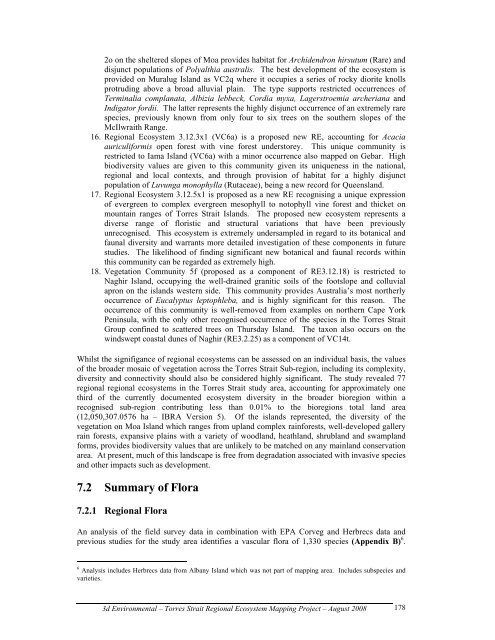Appendix 2 - Vegetation Communities and Regional Ecosystems
Appendix 2 - Vegetation Communities and Regional Ecosystems
Appendix 2 - Vegetation Communities and Regional Ecosystems
You also want an ePaper? Increase the reach of your titles
YUMPU automatically turns print PDFs into web optimized ePapers that Google loves.
2o on the sheltered slopes of Moa provides habitat for Archidendron hirsutum (Rare) <strong>and</strong><br />
disjunct populations of Polyalthia australis. The best development of the ecosystem is<br />
provided on Muralug Isl<strong>and</strong> as VC2q where it occupies a series of rocky diorite knolls<br />
protruding above a broad alluvial plain. The type supports restricted occurrences of<br />
Terminalia complanata, Albizia lebbeck, Cordia myxa, Lagerstroemia archeriana <strong>and</strong><br />
Indigator fordii. The latter represents the highly disjunct occurrence of an extremely rare<br />
species, previously known from only four to six trees on the southern slopes of the<br />
McIlwraith Range.<br />
16. <strong>Regional</strong> Ecosystem 3.12.3x1 (VC6a) is a proposed new RE, accounting for Acacia<br />
auriculiformis open forest with vine forest understorey. This unique community is<br />
restricted to Iama Isl<strong>and</strong> (VC6a) with a minor occurrence also mapped on Gebar. High<br />
biodiversity values are given to this community given its uniqueness in the national,<br />
regional <strong>and</strong> local contexts, <strong>and</strong> through provision of habitat for a highly disjunct<br />
population of Luvunga monophylla (Rutaceae), being a new record for Queensl<strong>and</strong>.<br />
17. <strong>Regional</strong> Ecosystem 3.12.5x1 is proposed as a new RE recognising a unique expression<br />
of evergreen to complex evergreen mesophyll to notophyll vine forest <strong>and</strong> thicket on<br />
mountain ranges of Torres Strait Isl<strong>and</strong>s. The proposed new ecosystem represents a<br />
diverse range of floristic <strong>and</strong> structural variations that have been previously<br />
unrecognised. This ecosystem is extremely undersampled in regard to its botanical <strong>and</strong><br />
faunal diversity <strong>and</strong> warrants more detailed investigation of these components in future<br />
studies. The likelihood of finding significant new botanical <strong>and</strong> faunal records within<br />
this community can be regarded as extremely high.<br />
18. <strong>Vegetation</strong> Community 5f (proposed as a component of RE3.12.18) is restricted to<br />
Naghir Isl<strong>and</strong>, occupying the well-drained granitic soils of the footslope <strong>and</strong> colluvial<br />
apron on the isl<strong>and</strong>s western side. This community provides Australia’s most northerly<br />
occurrence of Eucalyptus leptophleba, <strong>and</strong> is highly significant for this reason. The<br />
occurrence of this community is well-removed from examples on northern Cape York<br />
Peninsula, with the only other recognised occurrence of the species in the Torres Strait<br />
Group confined to scattered trees on Thursday Isl<strong>and</strong>. The taxon also occurs on the<br />
windswept coastal dunes of Naghir (RE3.2.25) as a component of VC14t.<br />
Whilst the signifigance of regional ecosystems can be assessed on an individual basis, the values<br />
of the broader mosaic of vegetation across the Torres Strait Sub-region, including its complexity,<br />
diversity <strong>and</strong> connectivity should also be considered highly significant. The study revealed 77<br />
regional regional ecosystems in the Torres Strait study area, accounting for approximately one<br />
third of the currently documented ecosystem diversity in the broader bioregion within a<br />
recognised sub-region contributing less than 0.01% to the bioregions total l<strong>and</strong> area<br />
(12,050,307.0576 ha – IBRA Version 5). Of the isl<strong>and</strong>s represented, the diversity of the<br />
vegetation on Moa Isl<strong>and</strong> which ranges from upl<strong>and</strong> complex rainforests, well-developed gallery<br />
rain forests, expansive plains with a variety of woodl<strong>and</strong>, heathl<strong>and</strong>, shrubl<strong>and</strong> <strong>and</strong> swampl<strong>and</strong><br />
forms, provides biodiversity values that are unlikely to be matched on any mainl<strong>and</strong> conservation<br />
area. At present, much of this l<strong>and</strong>scape is free from degradation associated with invasive species<br />
<strong>and</strong> other impacts such as development.<br />
7.2 Summary of Flora<br />
7.2.1 <strong>Regional</strong> Flora<br />
An analysis of the field survey data in combination with EPA Corveg <strong>and</strong> Herbrecs data <strong>and</strong><br />
previous studies for the study area identifies a vascular flora of 1,330 species (<strong>Appendix</strong> B) 6 .<br />
6<br />
Analysis includes Herbrecs data from Albany Isl<strong>and</strong> which was not part of mapping area. Includes subspecies <strong>and</strong><br />
varieties.<br />
3d Environmental – Torres Strait <strong>Regional</strong> Ecosystem Mapping Project – August 2008<br />
178


